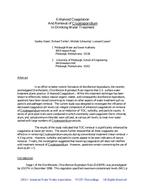Description
In an effort to better control formation of disinfection byproducts, the recently promulgated Disinfectants/Disinfection Byproduct Rule requires that U.S. surface water treatment plants practice enhanced coagulation. While this treatment technique has been shown to effectively reduce natural organic matter, and consequently disinfection byproducts, questions have been raised concerning its impact on other aspects of water treatment such as particle and pathogen removal. The current study was designed to investigate the influence of decreased coagulation pH levels (an integral component of enhanced coagulation) on removal of Cryptosporidium oocysts as well as on reduction of TOC, turbidity, and particle counts. A series of pilot plant trials were conducted in which commonly used coagulants (ferric chloride, alum, and polyaluminum chloride) were utilized, at various pH levels, to treat river water spiked with large numbers of Cryptosporidium oocysts. The results of the study indicated that TOC removal is significantly enhanced by coagulation at lower pH levels. The results further showed that all three coagulants are effective in removing Cryptosporidium oocysts during conventional treatment (mean removal = 4.3 log units). However, turbidity and particle counts appear to be poor indicators of oocyst removal. Finally, the investigation suggested that lowering coagulation pH does not interfere with treatment removal of Cryptosporidium. However, questions remain concerning the use of alum at pH = 5. Includes 21 references, table, figures.
Product Details
- Edition:
- Vol. – No.
- Published:
- 01/01/2001
- Number of Pages:
- 27
- File Size:
- 1 file , 300 KB
- Note:
- This product is unavailable in Ukraine, Russia, Belarus





